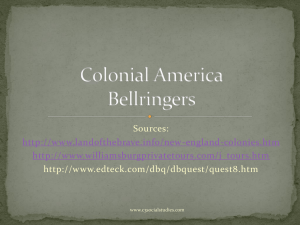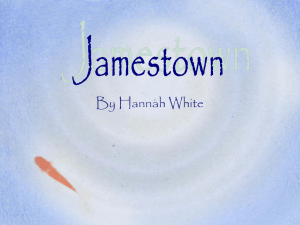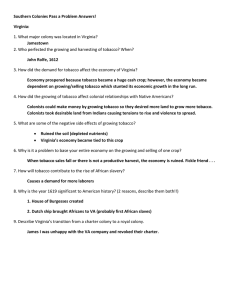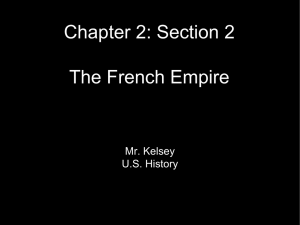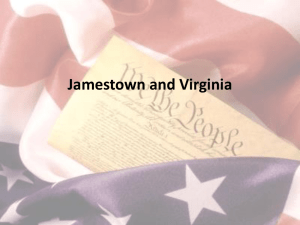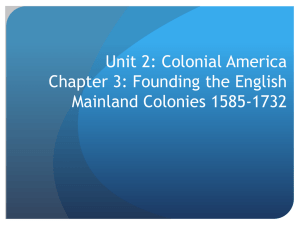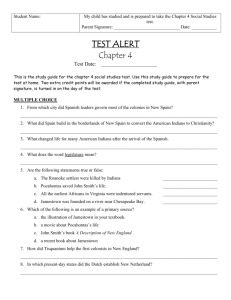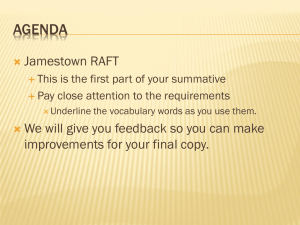Chapter 2 Notes
advertisement
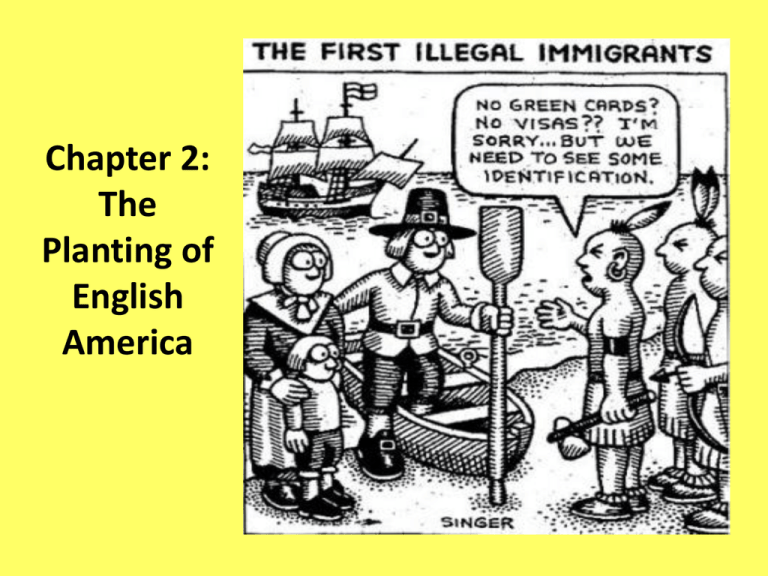
Chapter 2: The Planting of English America N Am: Spanish occupied Santa Fe French occupied Quebec English occupied Jamestown England: Religious conflict King Henry VIII broke w/ C-Church started Prot. Reformation. Daughter - Elizabeth I – raised to be a devout Prot. Ireland - predominately Cath. asked Sp for help against Elizabeth I. Elizabeth I’s troops crushed Irish (Cath) uprising--conflict still exists Elizabeth I: (Queen 1558-1603) Religion: promoted Protestantism Catholicism God Pope Priest Hierarchy Peasant Protestantism God Peasant Queen Elizabeth I of England King Philip II of Spain “Sea dogs” plundered the Spanish Main/Armada (carrying gold/supplies from New World). Best “sea dog” - Francis Drake later knighted for his success (allowed crown to take a share of his bounty) Colonization: 1583 - Humphrey Gilbert explored Newfoundland - unsuccessful. 1585 - Walter Raleigh (1/2 brother of Gilbert) est. settlement at Roanoke Is, NC also proved to be unsuccessful – disappeared. 1588 - Sp King Philip II’s Sp Armada defeated impact: helped to ensure Eng’s naval dominance in N Atlantic English Characteristics: 1. strong, unified national state 2. popular monarch 3. some religious unity 4. sense of nationalism and national destiny to rule/expand. Golden Age of Literature illustrated: 1. thirst for adventure 2. curiosity of unknown 3. spirit of self-confidence 4. vibrant patriotism 5. restlessness England Early 1600s - Stage is set for colonization a. enclosure of croplands - feudal system being replaced by sheep industry more b. small farmers (part of feudal system) now unemployed. c. creation of laws of primogeniture - eldest son inherits; younger sons look elsewhere. d. some form of religious toleration/freedom. e. New World = new market f. birth of joint-stock companies - investors pool $; form company whose main intent to make a profit. Virginia Co. of London received charter from King James I to settle in New World; est. Va Colony. a. Special - guaranteed overseas settlers same rights as those Englishmen at home. b. Late 1606 - 3 ships land in Chesapeake Bay area (1607)- attacked by Indians - move further up into Bay; land along James River (easily defendable but mosquito infested). c. Most die of disease, malnutrition, and starvation--gentlemen interested only in finding gold not settlement. d. John Smith kidnapped by Indians in 1607; saved by Pocahontas; returns in 1608 to take “charge” -- “He who shall not work, shall not eat! e. 1609-10 - “Starving Time” - of 400 only 60 survive; want to go home; leave but encounter reinforcements under Lord De La Warr who ordered them to turn around; took control. f. First Powhatan War: Lord De La Warr organized military action using Irish tactics of raiding Indian villages (burned houses; took supplies; torched cornfields). Peace 1614 with marriage of Pocahontas and John Rolfe. g. Second Powhatan War (1644): last attempt by Indians to get rid of Jamestown members; failed. Result: Ind. banished from area and formally separated Ind/white areas of settlement. – Powhatan failed because of 3 D’s: a. Disease - small pox, measles b. Disorganization - lacked unity among Indians c. Disposability - Indians had no real value 1. couldn’t put to work in mines - no economic function 2. no reliable labor source 3. no valuable commodities to offer commerce Result: get rid of w/o harming colonial economy. Saving Grace: TOBACCO Pocahontas tells Rolfe secret of growing tobacco – cash crop. King Nicotine: a. planted extensively - even in streets b. caused price fluctuation - everyone planted it c. ruins soil - takes nitrogen out of soil d. promoted broad-base plantation system with demand for labor 1619 - Dutch sold 20 African slaves in Jamestown - planted “seeds” of slave system. h. 1619 - House of Burgesses formed - assembly to handle certain local problems i. 1624 - King James I mad at Va Co/Jamestown: 1. hates tobacco personally even though it makes $ 2. distrusts House of Burgesses - making their own decisions. Result: revokes Va Co’s charter with a royal charter thus making Jamestown a royal colony under the direct control of the King. Maryland Colony (1634) Lord Baltimore establishes colony to: 1. make $ 2. create catholic haven a. Huge estates were granted to Cath. relatives b. Prot. want to come/granted sm. farms on the outskirts of town. c. Colony founded on tobacco. d. Labor: indentured servants penniless people who worked off their passage. 1649 - Lord Baltimore - passed the Act of Toleration - granted religious toleration to all CHRISTIANS -- Jews and Atheists were still persecuted. England -- Mid-1600s W Indies Is. (esp. Jamaica) 1. sugar plantations - rich man’s crop vs. tobacco’s poor man’s crop in N Am. (planted cane, harvest, refine, then get final product) 2. imported African slaves (could afford it and eventually slaves will outnumber whites 4:1) 3. to maintain control – created “slave codes” most famous - 1661 - Barbados slave codes - denied most fundamental rts and allowed masters complete domination and use (including the rt to punish). English Politics: 1629 - Charles I dismisses Parliament 1640 - Charles I reestablishes Parliament but some were mutinous. 1649 - Charles I is beheaded and Oliver Cromwell takes over. 1660 - Charles II (son of previous King) overthrows Cromwell Restoration Period - rewarded 8 loyalists who help him “restore” the throne lg. land grants in Carolina - hope to grow food stuff, sugar cane, wine, silk, olive oil. By 1670 - became the link between N Am (food stuff) and W Indies (sugar cane). 1670 - Some Barbados English Settlers move to the Carolinas 1. brought few Africans 2. imported “slave codes” 3. enter slave business in Charlestown but were somewhat unwilling to export Indians to W. Indies. 1710 - bloody raids annihilated the “Savannah Indians”. 1. rice soon replaced other crops (sugar cane and tobacco) 2. called for African slaves - immune to malaria and knew how to grow rice. North Carolina’s Emergence: a. Poverty stricken outcasts and religious dissenters from Va moved south and became squatters - w/o legal rt to land. b. Sm. farmers of SC who snubbed aristocracy moved north – became squatters. c. Both befriend pirates/develop strong dislike for authority (like RI) Importance of Georgia Colony: SC’s prosperous sugar cane/rice industries were threatened by Sp Fla and hostile Indians from Fr. La. King George II’s problem solved when group of philanthropists, under James Oglethorpe, proposed setting up a buffer “colony” in N Am. Georgia’s Characteristics: a. Ga would soon thrive as a debtor’s colony b. Attracted all kinds of people - Germans, Scots Irish, etc. c. Allowed religious toleration for all Christians except Catholics. SOUTHERN COLONIES CHARACTERISTICS: (VA, MD, NC, SC, GA) a. produced profitable staple crops tobacco and rice b. slavery c. soil butchers - leads to expansion westward d. scattering of plantations - retarded growth of cities and made establishment of schools/churches difficult and expensive. e. some religious toleration - tax-supported Church of England – dominant faith.
